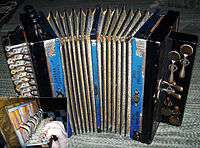Button accordion

A button accordion is a type of accordion on which the melody-side keyboard consists of a series of buttons rather than piano-style keys of a piano accordion. The first button accordion is credited to Franz Walther in 1850.[1]
Types of Button Accordions
A wide variation in keyboard systems, tuning, action and construction of these instruments exists. The two main examples of this are the chromatic button accordion and the diatonic button accordion. The single row button accordion, also known as the Cajun accordion to scholars, is another version of the button accordion.[2]
Diatonic Button Accordion The diatonic button accordion has two or three rows of buttons, each row tuned to a certain key. They are usually seen in music genres such as Cajun and Norteño music. Also considered Bisonoric, meaning that the same button can produce two sounds. Another feature is that accidentals are not included, usually there will be a third row of buttons to represent the accidentals (which in turn makes it a chromatic diatonic).
Chromatic Button Accordion The chromatic button accordion is unisonoric meaning that the same button produces one sound. This accordion also has 3-5 rows of buttons and are not limited to one specific key as are the diatonic button accordions. This type of accordion is very popular in French music.[3]
Main Components
There are four main components of any accordion: the reeds, bellows, buttons or keys, and the switches. The accordion has a treble side, which usually encases the reeds, and a bass side, which usually has the buttons and/or keys. The buttons or keys control the pitch which is on the treble side, and there are usually buttons on the bass side that are harder to see but can be tactfully identified with something like a gem or crosshatch pattern. The bellows are considered the life of the instruments as they are the ones expanding and contracting air into the reeds, and are usually made out of paper. Lastly, the switches control the timbre or voice of the instrument.[3]
See also
- List of All Ireland button accordion champions
- Garmon', Bayan (accordion) (Russian)
- Melodeon (accordion)
- Piano accordion
- Squeezebox
- Steirische Harmonika
- Bandoneon
References
- ↑ Strahl Harrington, Helmi; Kubik, Gerhard (2001). "Accordion". Grove Music Online (Oxford Music Online ed.). Oxford University Press. Retrieved 2014-09-18.
- ↑ Sexton, Rocky L. (January 1, 2001) [1st. Pub. 2000]. "Chapter 14: Zydeco Music and Race Relations in French Louisiana". In Kivisto, Peter & Rundblad, Georganne. Multiculturalism in the United States: Current Issues, Contemporary Voices. SAGE Publications. p. 176. ISBN 978-1-452-25174-5.
- 1 2 "Squeezebox stories". The Arhoolie Foundation.